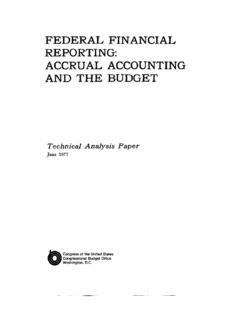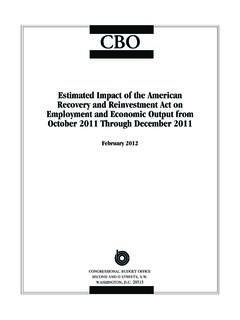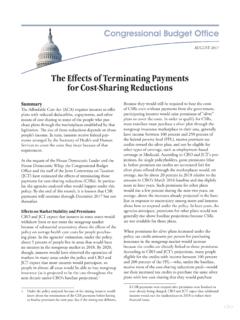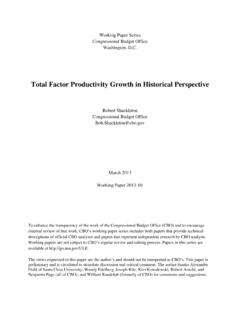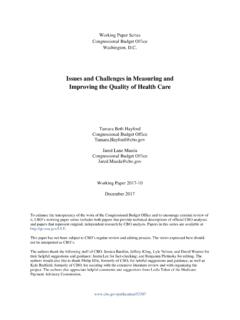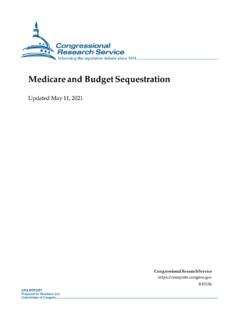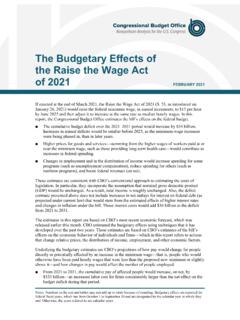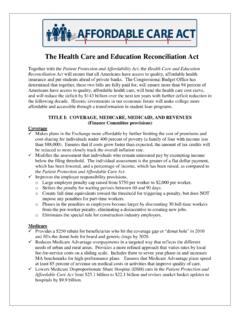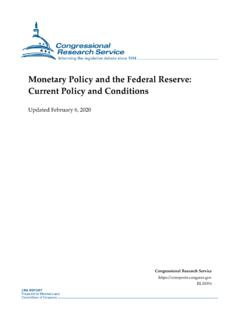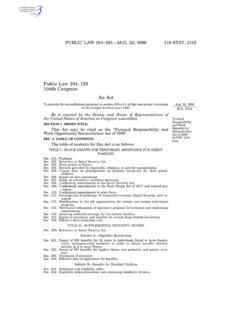Transcription of CBO Explains Budgetary Scorekeeping Guidelines
1 JANUARY | 2021 CBO Explains BudgetaryScorekeepingGuidelinesWhat Is Scorekeeping ? Scorekeeping is the process of developing and recording consistent measures of the Budgetary effects changes in federal spending, revenues, and deficits of proposed and enacted legis-lation. The process, which has developed over time, is governed by law, precedent, and rules. Scorekeeping recognizes the distinctions among the major categories within the budget and the jurisdictional boundaries between appropriation and authorization legislation: Revenues and direct spending are subject to rules and procedures that differ from those that apply to discretionary spending. A key purpose of Scorekeeping is to attribute Budgetary effects to the pieces of legislation that cause them, so that rules and procedures for budget enforcement may be Were the Guidelines Created? The Congress created the Scorekeeping guide-lines to help scorekeepers attribute Budgetary effects correctly and to minimize differences among scorekeepers measurements of specific Budgetary The Guidelines promote con-sistent treatment over time, across programs, and among the scorekeepers of proposed or enacted legislation.
2 As long as any changes are approved unanimously, the scorekeepers can revise and expand the Guidelines . The 16 current Scorekeeping Guidelines address a range of Budgetary situations, including how to account for transfers of funds between federal programs and how to record government pur-chases, leases, and sales of | @uscboWhen providing Budgetary information to the Congress and other audiences, the Congressional Budget Office adheres to laws and rules concerning the federal budget and to a set of principles that include 16 Scorekeeping Guidelines . This document provides information about four of the Guidelines that frequently result in questions to CBO from Congressional staff and others. Who Keeps Score? The House and Senate Committees on the Budget serve as the scorekeepers in the legislative branch. They assess the Budgetary effects of proposed legis-lation relative to particular Budgetary goals, and they enforce the Congress s Budgetary rules.
3 In the executive branch, the Office of Management and Budget records the Budgetary effects of enacted laws and enforces rules governing the Is CBO s Role?The Congressional Budget Office assists the budget committees by providing cost estimates at various points in the legislative process; it has no role in enforcement. CBO s baseline budget projections and cost estimates help the Congress to identify a bill s possible effects on the federal budget and to determine whether legislation would comply with Budgetary rules. CBO incorporates estimates from the staff of the Joint Committee on Taxation the official estimators for tax legislation consid-ered by the Congress. CBO estimates the costs of proposed legislation relative to current law for revenues and direct spending, as represented by its baseline projections. In developing its cost estimates, CBO applies the Scorekeeping Guidelines and consults with the scorekeepers as needed. CBO s cost estimates are advisory only; the budget committees can (but need not) use them to achieve Budgetary goals.
4 Most of CBO s formal cost estimates are prepared for bills approved by full committees in either chamber, as required by law. Upon request, the agency also can provide preliminary estimates and other tech-nical assistance as a committee considers whether to advance a bill, as amendments are debated, and at other stages in the process. 2 CBO Explains Budgetary Scorekeeping Guidelines JANUARY | @uscboCBO applies the Guidelines routinely but is asked often to explain four in particular: Guideline 3, which specifies when to record the Budgetary effects of provisions in appropriation legislation that affect direct spending and revenues; Guideline 14, which applies to estimates of direct spending and revenues for provisions in authorization legislation that involve program management or administration; Guideline 6, which applies to extending the period for which funding may be available; and Guideline 10, which applies to the Budgetary effects of provisions that are contingent on the enactment of future legislation or on other actions or events that are beyond lawmakers control.
5 Guideline 3: Direct Spending Programs Revenues, entitlements and other mandatory programs (including offsetting receipts) will be scored at current law levels, as defined in section 257 [of the Balanced Budget and Emergency deficit Control Act of 1985, also called the deficit Control Act], unless congressional action modifies the authorizing legislation. Substantive changes to or restrictions on entitlement law or other mandatory spending law in appropriations laws will be scored against the Appropriations Committee s section 302(b) allocations in the House and the Senate. For the purpose of [scoring under the Congressional Budget Act of 1974], direct spending savings that are included in both an appropriations bill and a reconciliation bill will be scored to the reconciliation bill and not to the appropriations bill. For scoring under sections 251 or 252 of [the deficit Control Act], such provisions will be scored to the first bill enacted. Guideline 3 directs scorekeepers, when estimating the cost of appropriation bills, to exclude anticipated changes to mandatory spending or revenues that may result if the bill only increases or decreases discretion-ary funding for related activities (rather than making substantive changes to the way a program operates).
6 Thus, guideline 3 addresses jurisdictional boundaries between appropriation legislation and authorization legislation. It requires that estimates for appropria-tion bills include only the Budgetary effects of the Key Terms The Scorekeeping process, like the federal budget process, distinguishes between two types of federal legislation on the basis of the Congressional committees that originate them: appropriation legislation and authorization legislation. Discretionary spending stems from authority provided in appropriation acts; direct (or mandatory) spending and revenues (tax receipts and other collections that arise from the federal government s use of its sov-ereign power) are generally controlled by laws other than appropriation acts are statutes under the jurisdiction of the House or Senate Committee on Appropriations that provide budget author-ity, which allows federal agencies to incur obligations and to make payments from the Treasury called outlays for specified pur-poses.
7 The Congress normally considers 12 regular appropriation acts, which fund the operations of the federal government for a fis-cal year. Mechanisms of budget enforcement for appropriation legislation focus primarily on the amount of budget authority provided for the upcoming budget acts are substantive legislation proposed by committees other than the House or Senate Committees on Appropriations, such as the House Committee on Agriculture or the Senate Committee on Veterans Affairs. Such acts can establish, continue, curtail, or strengthen the operation of specific federal programs or agencies, either indefinitely or for a specific period. Authorization acts also may allow a particular type of obligation or expendi-ture within a program. Some but not all provide budget authority. Others authorize appropria-tions but require further Congressional action (an appropriation, for example) before federal agencies can incur obligations. Mechanisms of budget enforcement do not apply to pro-visions of those laws that merely authorize appropriations; rather, those mechanisms focus on how authorization legislation would affect direct spending outlays, revenues, and 2021 CBO Explains Budgetary Scorekeeping | @uscboamounts that would specifically be provided.
8 Indirect effects that could result when an agency spends the discretionary funds are excluded. Example: In recent years, the annual appropriation act that funds the Department of Health and Human Services provided discretionary funding for program integrity initiatives, which aim to reduce overpayments for mandatory benefit programs by improving the accuracy of some federal payments to health care providers. Reducing such improper payments might result in less direct spending, but guideline 3 prevents CBO from attributing those estimated savings to the appropriation bill. By contrast, guideline 3 also requires that cost esti-mates for appropriation bills include the effects of provisions that make substantive changes to manda-tory spending programs such as modifying eligibility requirements or changing operations. (Such provisions are called CHIMPs, changes in mandatory programs.) Under guideline 3, CBO s estimates for appropriation bills include such changes in mandatory spending as though they were changes in discretionary Example: A provision of the Further Additional Supplemental Appropriations for Disaster Relief Requirements Act, 2018, doubled the maximum land area needed to qualify for federal disaster assistance under a mandatory spending program of the Department of CBO estimated that the provision would increase direct spending budget authority and outlays.
9 Guideline 3 required that amount to be included in the cost estimate as though it were discretionary spending. Guideline 14: Scoring of Receipt Increases or Direct Spending Reductions for Additional Administrative Program Management Expenses No increase in receipts or decrease in direct spending will be scored as a result of provisions of a law that provides direct spending for administrative or program management activities. Guideline 14 directs scorekeepers to exclude from cost estimates any Budgetary savings that might arise when mandatory funding is provided for program management or administration. Guideline 14 applies only to authorization legislation, whereas guideline 3 addresses appropriation legislation. Unlike guide-line 3, however, guideline 14 is asymmetrical. It was adopted in part to avert cases in which possible, but uncertain, savings were used to offset near-term increases in spending resulting from the same 14 excludes possible decreases in the deficit that might result from spending on program management or administration but allows for possi-ble increases in the (Under guideline 3, both would be excluded from the estimate for an appro-priation bill.)
10 For example, under guideline 14, if a bill would provide additional mandatory funding to com-bat fraud in a program with mandatory funding, only the costs of implementing that provision are counted; any savings that might result are not considered. Example: S. 1871, the SGR Repeal and Medicare Beneficiary Improvement Act of 2013, would have increased mandatory funding to reduce improper payments in Medicare and Medicaid. According to CBO s cost estimate ( ), those program integrity provisions also would have reduced spending for benefits. In keeping with guideline 14, the estimated reduction in spending on benefits was not credited as an offset to the estimated increase in spending on a provision of a bill would give an agency new or expanded authority to manage or administer a pro-gram in a different way, CBO s estimate can include the Budgetary savings attributable to that provision. If the extent of that authority is unclear, CBO con-sults with the scorekeepers about including the estimated savings.

